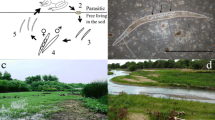Abstract
Larvae of Metastrongylus spp. lungworms infect wild boar (Sus scrofa) definitive hosts through earthworms (Lumbricidae). We compared the abundance and Metastrongylus spp. larval infection measures of earthworms between two areas (both in Zselic, Hungary, 2012) characterized by markedly different wild boar population densities. Estimated wild boar density was 0.03 animal/ha in free range area and 1.03 animal/ha in enclosure. The mean abundance of earthworm populations (mostly Allolobophora, Aporrectodea, and Lumbricus spp.) was assessed by analysing 140–140 soil samples. The assesment of Metastrongylus spp. larval infection measures was based on cca 100–100 earthworms derived from the two areas. The abundance of earthworms and their Metastrongylus spp. larval infection measures (prevalence and mean intensity) were significantly lower in the free range than in the enclosure. Furthermore, using a finer scale within the enclosure, we compared wild boar feeding sites (n = 30) to other sites (n = 75). Earthworm populations were significantly more abundant and carried significantly more prevalent and more abundant larval lungworm infections at the former sites. These results suggest that high wild boar density and forage supplementation in enclosures increase both the abundance and the larval Metastrongylus infections of earthworms.
Similar content being viewed by others
References
Alicata J.E. 1935. Early developmental stages of nematodes occuring in swine. Technical Bulletin, No. 489, United States Department of Agriculture, Washington, D.C., 33–44
Altizer S., Nunn C.L., Thrall P.H., Gittleman J.L., Antonovics J., Cunningham A.A., Dobson A.P., Ezenwa V., Jones K.E., Pedersen A.B., Poss M. and Pulliam, J.R.C. 2003. Social organization and parasite risk in mammals: integratingtheory and empirical studies. Annual Review of Ecology, Evolution and Systematics, 34: 517–547. DOI: 10.1146/annurev.ecolsys.34.030102.151725
Arneberg P., Skorping A., Grenfell B. and Read A.F. 1998. Host densities as determinants of abundance in parasites communites. Proceedings of Royal Society B, 265, 1283–1289. DOI: 10.98/rspb.1998.0431
Bagge A.M., Pouling R. and Valtonen E. T. 2008. Fish population size, and not density, as the determining factor of parasite infection: a case study. Parasitology, 128, 305–313. DOI: 10.1017/S0031182003004566
Bush A.O., Lafferty K.D., Lotz J.M. and Shostak A.W. 1997. Parasitology meets ecology on its own terms: Margolis et al. revisited. Journal of Parasitology, 83, 575–583
Cross P.C., Drewe J., Patrek V., Pearce G., Samuel M.D. and Delahay R.J. 2009. Wildlife population structure and parasite transmission: implications for disease management In: Delahay R.J., Simth G.C. and Hutchings M.R (Eds) Management of Disease in Wild Mammals, Springer, e-ISBN: 978-4-431-77134-0, 9–29. DOI: 10.1007/978-4-431-77134-0
Hechinger R.F. and Lafferty K.D. 2005. Host diversity begets parasite diversity: bird final hosts and trematodes in snail intermediate hosts. Proceedings of Royal Society B, 272, 1059–1066. DOI:10.1098/rspb.2005.3070
Humbert J-F. and Henry C. 1989. Studies on prevalence and transmission of lung and stomach nematodes of the wild boar (Sus scrofa) in France. Journal of Wildlife Diseases, 25, 335–341. DOI: 10.7589/0090-3558-25.3.335
Jaliv H. and Kooch Y. 2012. Factors influence and distribution and abundance of earthworm communities in different forest types (man-made and natural forest). International Journal of Green and Herbal Chemistry, 1, 26–38. E-ISSN: 2278-3229
Lindsey A., Mehta M., Dhulipala V., Oberhauser K., and Altizer S. 2009. Crowding and disease: effects of host density on response to infection in a butterflyparasite interaction. Ecological Entomology, 34: 551–561. DOI: 10.1111/j.1365-2311.2009.01107.x
Navarro-González N., Serrano E., Casas-Díaz E., Velarde R., Marco I., Rossi L. and Lavín S. 2010. Game restocking and the introduction of sarcoptic mange in wild rabbit in north-eastern Spain. Animal Conservation, 13: 586–591. DOI: 10.1111/j.1469-1795.2010.00390.x
Navarro-González N., Fernández-Llario P., Pérez E., Mentaberre, G., López-Martin J.M., Lavín S. and Serrano E. 2013. Supplemental feeding drives endoparasite infection in wild boar in Western Spain. Veterinary Parasitology, 196, 114–123. DOI: 10.1016/j.vetpar.2013.02.019
Reiczigel J. 2003. Confidence intervals for the binomial parameter: some new considerations. Statistics in Medicine, 22: 611–621. DOI: 10.1002/sim.1320)
Reiczigel J. and Rózsa L. 2005. Quantitative Parasitology 3.0, http://www.zoologia.hu/qp/qp.html
Richard B., Legras M., Margerie P., Mathieu J., Barot S., Caro G., Desjardins T., Dubs F., Dupont L. and Decaëns T. 2012. Spatial distribution of earthworm assemblages in pastures of northwestern France. European Journal of Soil Biology, 53, 62–69. DOI: 10.1016/j.ejsobi.2012.08.005
Riley H., Pommeresche R., Eltun R., Hansen S. and Korsaeth A. 2008. Soil structure, organic matter and earthworm activity of cropping systems with contrasting tillage, fertilizer levels and manure use. Agriculture, Ecosystem and Environment, 124, 275–284. DOI:10.1016/j.agee.2007.11.002
Saitoh T. and Takahashi K. 1998. The role of vole population in prevalence of parasite (Echinococcus multilocularis) in foxes. Researches on Population Ecology, 40, 97–105. DOI: 10.1007/BF02765225
Schwartz B. and Alicata J.E. 1934. Life history of lungworms parasitic in swine. Technical Bulletin, No. 456, United States Department of Agriculture, Washington, D.C., 1–41
Vicente J., Höfle U., Garrido J.M., Fernández-de-Mera I.G., Acevedo P., Juste R., Barral M. and Gortázar C. 2007. Risk factors associated with the prevalence of tuberculosis-like lesions in fenced wild boar and red deer in south central Spain. Veterinary Research, 38, 451–464. DOI: 10.1051/vetres:2007002
Walker M., Hall A., Anderson R. M. and Basáñez M-G. 2009. Density-dependent effects on the weight of female Ascaris lumbricoides infections of humans and its impact on patterns of egg production. Parasites and Vectors 2, 11, DOI: 10.1186/1756-3305-2-11
Author information
Authors and Affiliations
Corresponding author
Rights and permissions
About this article
Cite this article
Nagy, G., Csivincsik, Á. & Sugár, L. Wild boar density drives Metastrongylus infection in earthworm. Acta Parasit. 60, 35–39 (2015). https://doi.org/10.1515/ap-2015-0005
Received:
Revised:
Accepted:
Published:
Issue Date:
DOI: https://doi.org/10.1515/ap-2015-0005




